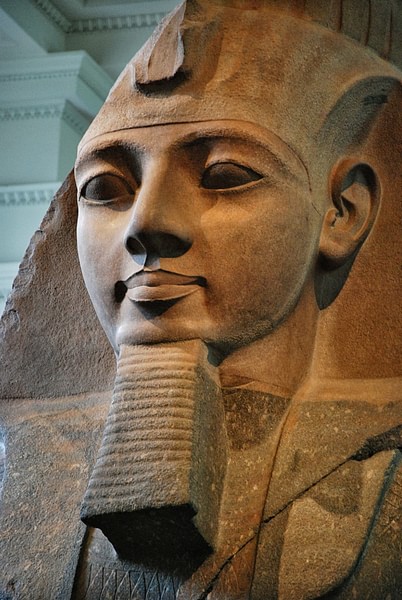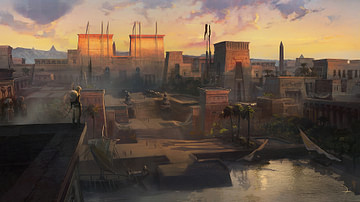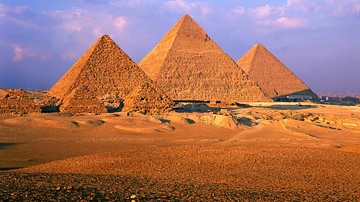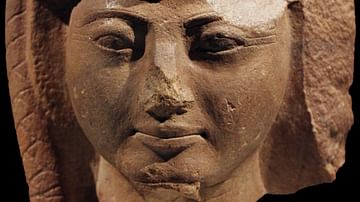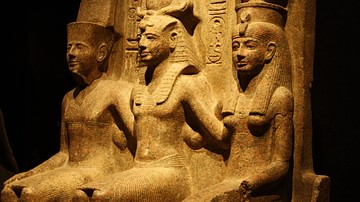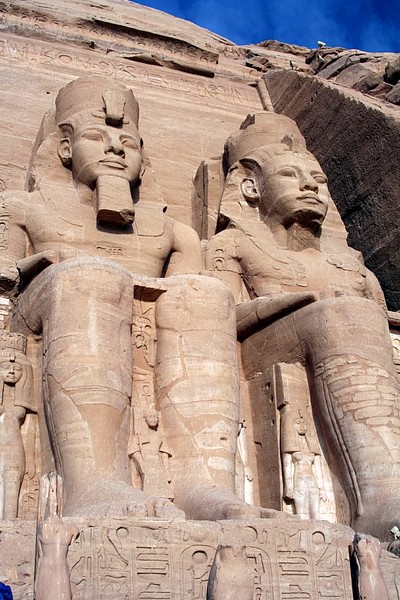
Ramesses II (r. 1279-1213 BCE, alternative spellings: Ramses, Rameses) was known to the Egyptians as Userma'atre'setepenre, which means 'Keeper of Harmony and Balance, Strong in Right, Elect of Ra'. He is also known also as Ozymandias and as Ramesses the Great.
He was the third pharaoh of the 19th Dynasty (1292-1186 BCE) who claimed to have won a decisive victory over the Hittites at The Battle of Kadesh and used this event to enhance his reputation as a great warrior. In reality, the battle was more of a draw than a decisive victory for either side but resulted in the world's first known peace treaty in 1258 BCE. Although he is regularly associated with the pharaoh from the biblical Book of Exodus there is no historical or archaeological evidence for this whatsoever.
Ramesses lived to be ninety-six years old, had over 200 wives and concubines, ninety-six sons and sixty daughters, most of whom he outlived. So long was his reign that all of his subjects, when he died, had been born knowing Ramesses as pharaoh and there was widespread panic that the world would end with the death of their king. He had his name and accomplishments inscribed from one end of Egypt to the other and there is virtually no ancient site in Egypt which does not make mention of Ramesses the Great.
Early Life and campaigns
Ramesses was the son of Seti I and Queen Tuya and accompanied his father on military campaigns in Libya and Palestine at the age of 14. By the age of 22 Ramesses was leading his own campaigns in Nubia with his own sons, Khaemweset and Amunhirwenemef, and was named co-ruler with Seti. With his father, Ramesses set about vast restoration projects and built a new palace at Avaris. The Egyptians had long had an uneasy relationship with the kingdom of the Hittites (in modern-day Asia Minor) who had grown in power to dominate the region.
Under the Hittite king Suppiluliuma I (r. 1344-1322 BCE), Egypt had lost many important trading centers in Syria and Canaan. Seti I recaptured the most coveted center, Kadesh in Syria, but it had been taken back by the Hittite king Muwatalli II (r. 1295-1272 BCE). After the death of Seti I in 1290 BCE, Ramesses assumed the throne and at once began military campaigns to restore the borders of Egypt, ensure trade routes, and take back from the Hittites what he felt rightfully belonged to him.
In the second year of his reign, Ramesses defeated the Sea Peoples off the coast of the Nile Delta. According to his account, these were a people known as the Sherdan who were allies of the Hittites. Ramesses laid a trap for them by placing a small naval contingent at the mouth of the Nile to lure the Sherdan warships in. Once they had engaged the meager fleet, he launched his full attack from both sides, sinking their ships. Many of the Sherdan who survived the battle were then pressed into his army, some even serving as his elite bodyguard. The Sea Peoples' origin and ethnicity is unknown, although many theories have been suggested, but Ramesses describes them in his account as Hittite allies and this is important as it underscores the relationship between the Egyptians and Hittites at this time.
At some point, prior to the year 1275 BCE, he began construction of his great city Per-Ramesses ("House of Ramesses") in the Eastern Delta region near to the older city of Avaris. Per-Ramesses would be his capital (and remain an important urban centre throughout the Ramesside Period), a pleasure palace, and a military compound from which he would launch campaigns into neighboring regions.
It was not only an armory, military stable, and training ground but was so beautifully constructed that it rivalled the magnificence of the ancient city of Thebes. It is possible, as some scholars suggest, that Per-Ramesses was actually founded - and construction begun - by Seti I because it was already a functioning military centre by the time Ramesses II launched his campaigns in 1275 BCE.
Ramesses marched his army into Canaan which had been a Hittite vassal state since the reign of the Hittite king Suppiluliuma I. This campaign was successful and Ramesses returned home with plunder and Canaanite (and probably Hittite) royalty as prisoners. The historian Susan Wise Bauer comments:
At twenty-five, the new pharaoh had already been living an adult life for at least ten years. He had married for the first time at fifteen or so, and had already fathered at least seven children. He had already fought in at least two of his father's campaigns up into the Western Semitic lands. He did not wait long before picking up the fight against the Hittite enemy. In 1275, only three years or so after taking the throne, he began to plan a campaign to get Kadesh back. The city had become more than a battle front; it was a symbolic foot-ball kicked back and forth between empires. Kadesh was too far north for easy control by the Egyptians, too far south for easy administration by the Hittites. Whichever empire claimed it could boast of superior strength. (247)
In late 1275 BCE, Ramesses prepared his army to march on Kadesh and waited only for the omens to be auspicious and word from his spies in Syria as to the enemy's strength and position. In 1274 BCE, when all seemed in his favor, he led some twenty thousand men out of Per-Ramesses into battle, the army divided into the four companies named after the gods: Amun, Ra, Ptah, and Set. Ramesses led the Amun division with the others following behind.
The Battle of Kadesh
They marched for two months before reaching a place where he felt confident in arranging his army in battle formation for attack on the city and waited with his Amun division, along with his sons, for the others to catch up. At this time, two Hittite spies were captured who, under torture, gave up the location of the Hittite army which they said was nowhere near the city. Reassured, Ramesses abandoned his plans for an immediate strike and gave orders for his division to encamp and wait for the rest of the army to arrive. The Hittite army, however, was actually less than a mile away and the two spies had been purposefully sent. As Ramesses was pitching camp, the Hittites roared out from behind the walls of Kadesh and struck.
The battle is described in Ramesses accounts, Poem of Pentaur and The Bulletin, in which he relates how the Amun division was completely overrun by the Hittites and the lines were broken. The Hittite cavalry was cutting down the Egyptian infantry and survivors were scrambling for the safety of their camp. Recognizing his situation, Ramesses called upon his protector god, Amun, and fought back. According to historian Margaret Bunson:
Ramesses brought calm and purpose to his small units and began to slice his way through the enemy in order to reach his southern forces. With only his household troops, with a few officers and followers, and with the rabble of the defeated units standing by, he mounted his chariot and discovered the extent of the forces against him. He then charged the eastern wing of the assembled foe with such ferocity that they gave way, allowing the Egyptians to escape the net which Muwatalli had cast for them. (131)
Ramesses had only just turned the tide of battle when the Ptah division arrived and he quickly ordered them to follow him in the attack. He drove the Hittites toward the Orontes River killing many of them while others drowned trying to escape. He had not considered the position his hasty charge might place him in, however, and was now caught between the Hittites and the river. All Muwatalli II needed to do to win at this point was to send his reserve troops into battle and Ramesses and his army would have been destroyed; yet, for some reason, the Hittite king did not do this. Ramesses rallied his forces and drove the Hittites from the field.
He then claimed a great victory for Egypt in that he had defeated his enemy in battle but the Battle of Kadesh nearly resulted in his defeat and death. According to his own reports, it was only owing to his own personal courage and calm in battle (and the goodwill of the gods) that he was able to turn the tide against the Hittites.
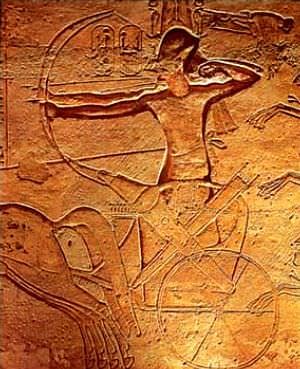
Rameses immortalized his feats at Kadesh in the Poem of Pentaur and The Bulletin in which he describes the battle as a dazzling victory for Egypt but Muwatalli II also claimed victory in that he had not lost the city to the Egyptians. The Battle of Kadesh led to the first peace treaty ever signed in the world between Ramesses II of Egypt and Muwatalli II's successor, Hattusili III (d. 1237 BCE) of the Hittite Empire.
After the Battle of Kadesh, Ramesses devoted himself to improving Egypt's infrastructure, strengthening its borders, and commissioning vast building projects commemorating his victory of 1274 and his other accomplishments.
Queen Nefertari & Later Life
The vast tomb complex known as the Ramesseum at Thebes, the temples at Abu Simbel, the hall at Karnak, the complex at Abydos and literally hundreds of other buildings, monuments, temples were all constructed by Ramesses. Many historians consider his reign the pinnacle of Egyptian art and culture and the famous Tomb of Nefertari with its wall paintings is cited as clear evidence of the truth of this claim. Nefertari was Ramesses' first wife and his favorite queen. Many depictions of Nefertari appear on temple walls and in statuary throughout his reign even though she seems to have died fairly early in their marriage (perhaps in child birth) and her tomb, even though discovered looted, was a work of art in construction and decoration.
After Nefertari, Ramesses elevated his secondary wife Isetnefret to the position of queen and, after her death, his daughters became his consorts. Even so, the memory of Nefertari seems to have always been close in his mind in that Ramesses had her likeness engraved on walls and statuary long after he had taken other wives. He always treated the children of these wives with equal regard and respect. Nefertari was the mother of his sons Rameses and Amunhirwenemef and Isetnefret the mother of Khaemwaset and yet all three were treated the same.
Ramesses as Pharaoh of Exodus
Although Ramesses has been popularly associated with the pharaoh of the biblical Book of Exodus, there is absolutely no evidence to support this claim. The association of the name `Ramesses' with the unnamed pharaoh of Egypt in the Bible became quite common after the success of Cecil B. DeMille's film The Ten Commandments in 1956. Film versions of the biblical story since, including the popular animated film Prince of Egypt (1998) and the more recent Exodus: Gods and Kings (2014) both followed the lead of DeMille's film but there is no historical support for this association.
Exodus 1:11 and 12:37 as well as Numbers 33:3 and 33:5 all mention Per-Ramesses as one of the cities the Israelite slaves labored on and also the city they departed Egypt from. There is no evidence of a mass exodus from the city - nor from any other city in the history of Egypt - and none to support the claim that Per-Ramesses was built by slave labor.
Extensive archaeological excavations at Giza and elsewhere throughout Egypt have unearthed ample evidence that the building projects completed under the reign of Ramesses II (and every other king of Egypt) used skilled and unskilled Egyptian laborers who were either paid for their time or who volunteered as part of their civic duty. The custom of Egyptian citizens volunteering their time to work on the king's building projects is well documented and it was even thought that, in the afterlife, souls would be called upon to work for Osiris, Lord of the Dead, on the building projects he would want. The practice of placing shabti dolls in the tombs and graves of the dead was precisely for this purpose: so the dolls would take the place of the deceased in work projects.
Further, Ramesses was famous for recording histories of his accomplishments and for embellishing the facts when they did not quite fit history as he wished it preserved. It seems highly unlikely that such a king would neglect to record (with or without a favorable slant) the plagues which allegedly fell upon Egypt or the flight of the Hebrew slaves. One need not rely solely on the inscriptions Ramesses himself ordered, however; the Egyptians, from the time they mastered writing c. 3200 BCE, kept very extensive records and none of them even hint at a large population of Hebrew slaves in Egypt much less their exodus.
Further, the literary works of the Egyptians from the Middle Kingdom through the Late Period provide numerous motifs, themes, and actual events which were made use of by the later scribes who wrote the biblical narratives. The association of Ramesses with the cruel, stubborn pharaoh of Exodus is unfortunate as it obscures the character of a man who was a great and noble ruler.
Legacy
The reign of Ramesses II has become somewhat controversial over the last century with some scholars claiming he was more of a showman and a propagandist than an effective king and others arguing the opposite. The records of his reign, however - both the written and the physical evidence of the temples and monuments - argue for a very stable and prosperous reign. He was one of the few rulers to live and rule long enough to take part in two Heb Sed festivals which were held every thirty years to rejuvenate the pharaoh. He secured the country's borders, increased its wealth, and widened its scope of trade and, if he boasted of his accomplishments in his inscriptions and monuments, it is because he had good reason to be proud.
Ramesses the Great's mummy shows that he stood over six feet in height with a strong, jutting jaw, thin nose and thick lips. He suffered from dental problems, severe arthritis, and hardening of the arteries and, most likely, died from old age or heart failure. He was known to later Egyptians as the 'Great Ancestor' and many pharaohs would do him the honor of taking his name as their own. Some of them, such as Ramessess III, are considered better rulers than he was; none of them, however, would surpass the grand achievements and glory of Ramesses the Great in the minds and hearts of the ancient Egyptians.
